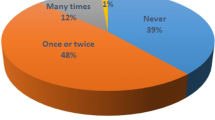Abstract
To gain an appreciation of the collusion rate of college students in science classes, over three hundred undergraduates from western Pennsylvania were sampled for their attitudes toward different forms of cheating. The science students were sampled from several different divisions within the university. The survey used in the study was developed by Baird (1980) and holds a reliability coefficient of 89%. The results of the survey indicate that eighty three percent of the respondents had cheated in science sometime in their lives. The vast majority (86%) of the pupils had “shared” homework answers with classmates and most (81%) had told “little lies” to teachers or administrators to avoid getting in trouble. Fewer, but still the majority (75%), of the students admitted to have copied phrases directly out of glossaries, encyclopedias, journals or reference books turning it in as their own work. Most students (80%) had also used crib notes or written science terms on their shoes, wrists or other parts of their body to get by “minor” quizzes at times in their biology course. Over three quarters of the students admitted to cheating on large exams and major projects. When the results of the study are compared to students surveyed with the same instrument a decade ago, it is revealed that the cheating among students is growing. Alarmingly, when the results of the 1993 study were compared to the one in 1980, it was discovered that student collusion had increased in all of the categories in the questionnaire.
Similar content being viewed by others
References
Baird, John (1980). Current trends in college cheating,Psychology in the Schools 17:515–521.
Borin, Norm and Gail, Tom (1988). Cheating in academe,Journal of Education for Business 63(4):153–157.
Collison, Michele (1990a). Apparent rise in students' cheating has college officials worried,Chronicle of Higher Education 36:34–35.
Collison, Michele (1990b). Study suggests college cheating is on the rise,Chronicle of Higher Education 37:31–32.
Drake, Clifford A. (1941). Why students' cheat,Journal of Higher Education 12:418–420.
Jendrek, Margaret (1989). Faculty reaction to academic dishonesty,Journal of College Student Development 30:401–406.
Kelly, Richard, and Wright, John (1974). Cheating: faculty and student attitudes,Improving College and University Teaching 24(1):31–34.
Nuss, Elizabeth M. (1984). Academic integrity: comparing faculty and student attitudes,Improving College and University Teaching 32(3):140–144.
Oaks, Harold, (1975). Cheating attitudes and practices at two state colleges,Improving College and University Teaching 23(4):232–235.
Schab, Fred, (1969). Cheating in high school: differences between the sexes,Journal of National Association of Women Deans and Counselors 33(1):39–42.
Schab, Fred, (1989). Schooling without learning, Unpublished paper, University of Georgia.
Stevens, George E. and Stevens, Faith W. (1987). Ethical inclinations of tomorrow's managers revisited: how and why students cheat,Journal of Education for Business 63:24–29.
Author information
Authors and Affiliations
Rights and permissions
About this article
Cite this article
Lord, T., Chiodo, D. A look at student cheating in college science classes. J Sci Educ Technol 4, 317–324 (1995). https://doi.org/10.1007/BF02211263
Issue Date:
DOI: https://doi.org/10.1007/BF02211263




